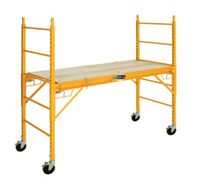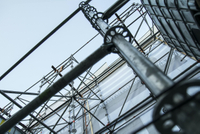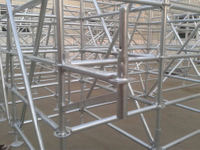Content Menu
● Introduction to Ringlock Scaffolding Load Capacity
● Key Factors Influencing Ringlock Scaffolding Load Capacity
>> Material Strength and Composition
>> Component Dimensions and Design
>> Scaffolding Configuration: Bay Size and Height
>> Foundation Stability and Base Plates
>> Bracing and Reinforcement
● Typical Load Capacity Values of Ringlock Scaffolding
>> Individual Component Capacities
>> Scaffold Towers and Systems
● Calculation Methods and Standards
● How to Maximize Ringlock Scaffolding Load Capacity
● Safety and Compliance Considerations
● Conclusion
● FAQ
>> 1. What is the typical load capacity of a single vertical standard in ringlock scaffolding?
>> 2. How does bay size affect ringlock scaffolding's load capacity?
>> 3. What role do diagonal braces play?
>> 4. Can the load capacity degrade over time?
>> 5. How should loads be placed on scaffolding platforms?
Ringlock scaffolding is widely acclaimed in the construction industry for its modular design, ease of assembly, and exceptional strength. However, understanding ringlock scaffolding load capacity is critical for contractors to ensure structural safety, optimize performance, and comply with applicable standards. This comprehensive guide breaks down the essentials contractors must know about load capacity—including factors influencing it, standard values, calculations, and practical tips.

Introduction to Ringlock Scaffolding Load Capacity
Ringlock scaffolding systems rely on a unique modular design characterized by rosette nodes welded to vertical standards, enabling multiple simultaneous connections through a wedge locking mechanism. Their design provides rapid assembly and excellent stability, but the load capacity depends on multiple variables, from materials to configuration.
For contractors, an accurate understanding of load capacity guards against overloading, scaffold failure, and ensures safety compliance while maintaining productivity on-site.
Key Factors Influencing Ringlock Scaffolding Load Capacity
Material Strength and Composition
Material choice significantly determines the maximum loads scaffolding can safely bear. Most ringlock scaffolding components use:
- Q345 (S355) structural steel: Strong, ductile, and widely used for heavy-duty applications.
- Yield strength around 345 MPa ensures robust resistance to bending and buckling.
- Hot-dip galvanization adds corrosion resistance without compromising strength.
Alternatives like aluminum are lighter but have different load capacities and are less common in heavy-duty ringlock scaffolding.
Component Dimensions and Design
- Vertical Standards: Often Ø48.3 mm tubes with 3.2 mm wall thickness in steel deliver high load capacities.
- Ledgers and Transoms: Typically Ø48.3 mm diameter tubes with thinner walls (~2.5 mm), suitable for transversal support.
- The rosette connection system (welded nodes) sidesteps weaknesses of traditional bolted clamps and creates highly rigid joints capable of distributing loads evenly.
Scaffolding Configuration: Bay Size and Height
- Bay size (distance between vertical standards) affects load distribution — smaller bays increase load capacity. Standard ledger spacing ranges from 1 to 2.5 meters.
- Load capacity decreases with height, due to increased buckling risk and lateral sway, requiring stricter bracing and potential additional reinforcement beyond approximately 30 meters.
- Typical scaffolds are designed to work within EN 12811 load classes, often up to class 3 or higher to support heavy traffic and material loads.
Foundation Stability and Base Plates
- The foundation must evenly distribute loads to prevent settlement and instability.
- Adjustable base plates (screw jacks) offer fine-level adjustments and help maintain vertical alignment.
- Sole boards or pads are critical when placed on soft or uneven ground to prevent sinking or tilting, which drastically reduces effective load capacity.
Bracing and Reinforcement
- Diagonal bracing is essential to resist lateral forces and sway, augmenting vertical load-bearing capacity.
- Double standards (two vertical supports at the same bay) increase load support for high-stress areas.
- Bracing must be placed correctly spaced vertically and horizontally to maintain stability, especially under wind load or dynamic forces.
Typical Load Capacity Values of Ringlock Scaffolding
Individual Component Capacities
Component | Typical Load Capacity |
Vertical Standard | 30–60 kN (6,700–13,500 lbf) per single leg; heavy-duty types up to ~136 kN (30,500 lbf) |
Ledger/Transom | 10–20 kN (~2,250–4,500 lbf) total load |
Diagonal Brace | Designed primarily for lateral stability rather than vertical load |
Platform Planks | Comply with Load Class 3 or 4, supporting 225–675 kg/m² with minimal deflection |
Scaffold Towers and Systems
- A four-leg ringlock scaffold tower typically supports around 10,000 kg (10 metric tons) when correctly assembled and braced on a proper foundation.
- Heavy-duty ringlock scaffolding systems (Type Z) can have an ultimate bearing capacity exceeding 546 kN (about 55 tons), allowing for very heavy or high-rise applications.
Note: Actual capacities are configuration-dependent; always consult manufacturers' specs.

Calculation Methods and Standards
Ringlock scaffolding load capacity is guided by international standards such as:
- JGJ231-2010: Technical specification for ringlock scaffolding in China
- EN 12810 and EN 12811: European scaffolding design standards
- OSHA: Safety regulations setting inspection and load requirements
Calculation involves variables like:
- Effective standard length: ::l0=ηh
- Load correction factors, safety coefficients (often 4x for ultimate strength)
- Load classes denoting permissible working surface pressures and live loads
How to Maximize Ringlock Scaffolding Load Capacity
Contractors can take the following steps to optimize load capacity and safety:
- Reduce ledger spacing and bay size to increase overall structural rigidity
- Use double vertical standards where higher loads are expected
- Install continuous diagonal bracing for lateral rigidity
- Ensure solid, level foundations with proper base plates and sole boards
- Use certified, corrosion-resistant materials to maintain strength longer
- Conduct regular inspections and replace degraded components immediately
- Distribute loads uniformly to prevent overloading isolated sections
- Work strictly following engineer-approved scaffold designs — especially for heights >30m
Safety and Compliance Considerations
- Never exceed safe working load (SWL) or imposed maximum loads from manufacturers
- Adhere to OSHA, EN 12810/12811, and local construction safety regulations
- Ensure qualified workers assemble, inspect, and maintain scaffolding
- Maintain detailed documentation for inspections and load calculations
- Follow site rules on load limits, equipment placement, and scaffold modifications
Conclusion
In conclusion, understanding ringlock scaffolding load capacity is essential for contractors aiming to optimize safety and efficiency. Factors such as material strength, component design, configuration, foundation support, and bracing profoundly influence how much load the scaffold can handle. By utilizing quality components, adhering to standards, and applying best practices, contractors can safely employ ringlock scaffolding across a broad range of construction projects — from residential builds to complex high-rise structures.

FAQ
1. What is the typical load capacity of a single vertical standard in ringlock scaffolding?
A single vertical standard generally supports between 30-60 kN, depending on height, steel grade, and configuration, with heavy-duty types supporting up to approximately 136.5 kN.
2. How does bay size affect ringlock scaffolding's load capacity?
Smaller bay sizes and reduced ledger spacing improve load capacity by making the structure more rigid and distributing loads evenly.
3. What role do diagonal braces play?
Diagonal braces provide lateral stability, reducing sway and increasing overall scaffold strength—important especially for taller scaffolds.
4. Can the load capacity degrade over time?
Yes. Corrosion, wear, and damage can reduce load capacity, so regular inspection and timely repair are critical.
5. How should loads be placed on scaffolding platforms?
Loads should be uniformly distributed to avoid concentrated pressure points that risk component overload.






















